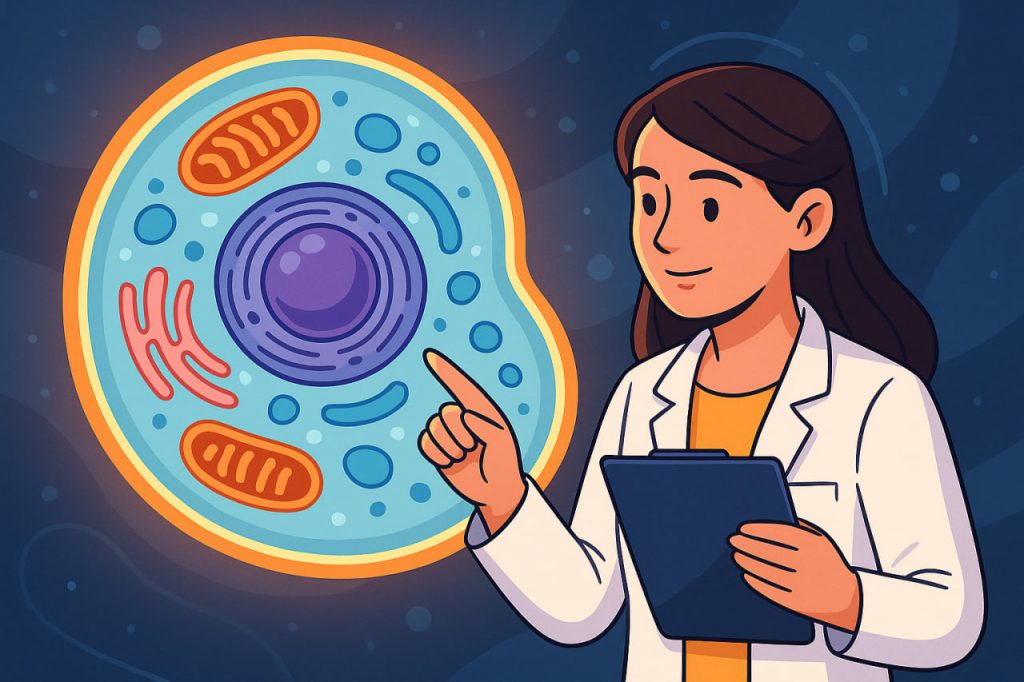Every human being is made up of trillions of microscopic units called cells, each one functioning as a self-contained system capable of producing energy, replicating, and maintaining life. Cells are the foundation of all biological processes — from muscle contraction and nerve signaling to immunity and reproduction. Although there are over 200 different types of human cells, they all share the same basic structure, fine-tuned over millions of years of evolution. Understanding how the human cell is built helps us grasp how life works at its most fundamental level.
The Basic Structure of the Human Cell
At its core, every human cell consists of three primary parts: the cell membrane, the cytoplasm, and the nucleus. The cell membrane acts as a protective barrier, maintaining the internal environment while regulating the exchange of substances with the outside world. Inside, the cytoplasm contains a gel-like fluid called cytosol, where organelles — the tiny “organs” of the cell — perform specialized tasks. The nucleus, often called the control center, houses the cell’s genetic material (DNA) and directs all activities, from protein synthesis to cell division. This internal coordination allows the cell to function with precision, adapting constantly to the body’s needs.
The Cell Membrane – Guardian and Gatekeeper
The cell membrane, or plasma membrane, is made of a double layer of phospholipids with embedded proteins and cholesterol molecules. This structure is often described as a fluid mosaic, because it combines flexibility with stability. The membrane not only provides shape and protection but also regulates what enters and exits the cell — nutrients come in, waste goes out. It also allows cell communication through receptors that recognize hormones, neurotransmitters, and other signaling molecules. Scientists compare the cell membrane to a “smart filter” that enables life by maintaining balance between the internal and external environments.
The Cytoplasm and Its Organelles
The cytoplasm is the bustling environment where most cellular reactions occur. Within it are numerous organelles, each with a distinct role:
- Mitochondria – The “powerhouses” of the cell, generating ATP through cellular respiration.
- Ribosomes – Tiny factories that synthesize proteins from genetic instructions.
- Endoplasmic Reticulum (ER) – A network of membranes; the rough ER helps build proteins, while the smooth ER produces lipids and detoxifies chemicals.
- Golgi Apparatus – Packages and ships proteins and other molecules to their destinations within or outside the cell.
- Lysosomes – Contain enzymes that digest waste and cellular debris.
- Peroxisomes – Break down fatty acids and neutralize toxic compounds.
- Cytoskeleton – A dynamic framework of protein filaments that maintains cell shape, anchors organelles, and enables movement.
Each organelle contributes to the cell’s efficiency, working together like departments within a highly organized company.
The Nucleus – Command Center of the Cell
The nucleus is the most prominent organelle in the cell and the keeper of genetic information. It contains chromatin, a complex of DNA and proteins that organize into chromosomes during cell division. Within the nucleus lies the nucleolus, where ribosomal RNA (rRNA) is produced — a key component of ribosomes. The nuclear envelope, a double membrane punctuated by nuclear pores, controls the movement of molecules like RNA and enzymes between the nucleus and cytoplasm. This tightly regulated system ensures that each cell accurately reads and expresses the genetic code that defines human life.
Specialized Cells and Their Functions
Although the fundamental structure of cells is universal, specialization allows for the diversity of tissues and organs in the human body. Muscle cells are elongated and packed with contractile fibers for movement, nerve cells (neurons) have long extensions for communication, and red blood cells lack a nucleus to maximize oxygen transport. Immune cells adapt to identify and destroy pathogens, while epithelial cells form protective layers on organs and skin. Each cell type is a masterpiece of form following function, optimized for its unique role in the body’s ecosystem.
Cellular Communication and Cooperation
Cells never work in isolation. Through complex chemical signaling, they communicate constantly with one another to maintain homeostasis — the body’s internal balance. Hormones, neurotransmitters, and signal transduction pathways coordinate everything from heartbeat to brain activity. Additionally, specialized proteins called receptors interpret external messages and trigger internal responses. This cellular “conversation” ensures that the body acts as a unified organism rather than a collection of independent parts.
Expert Perspectives on Human Cells
According to Dr. Bruce Alberts, a leading cell biologist and author of Molecular Biology of the Cell, “Each cell is a miniature universe — a dynamic, self-regulating system far more complex than any machine we’ve ever built.” Modern advances like CRISPR gene editing and stem cell research are expanding our ability to understand and manipulate these microscopic systems for medical breakthroughs. Dr. Jennifer Doudna, a pioneer in genetics, explains that studying cell structure not only helps treat diseases but also reveals how evolution shaped the architecture of life itself.
The Future of Cellular Research
New discoveries continue to reveal that cells are not static but highly adaptable. Single-cell sequencing now allows scientists to study individual cells’ genetic activity, uncovering how they respond to diseases like cancer. Organoid technology, which grows miniature organs in laboratories, lets researchers study complex tissues without testing on humans. These innovations promise a future where cellular engineering could repair damaged tissues, cure genetic disorders, and extend human longevity — all by harnessing the power of the cell’s natural design.
Interesting Facts
- The human body contains around 37 trillion cells.
- The smallest human cell is the sperm cell, while the largest is the female egg cell.
- Each cell completes about 10 million chemical reactions per second.
- Mitochondrial DNA is inherited almost exclusively from the mother.
- Cells can self-destruct through apoptosis to protect the body from cancer and infection.
Glossary
- Organelle – A specialized structure within a cell that performs a specific function.
- Cytoplasm – The fluid and organelles inside a cell, excluding the nucleus.
- Cell Membrane – The outer boundary that controls the passage of substances in and out of the cell.
- Nucleus – The organelle that contains genetic material and controls cell activity.
- Chromosomes – Thread-like structures made of DNA carrying genetic information.
- Ribosome – A small organelle responsible for protein synthesis.
- Homeostasis – The ability of an organism to maintain a stable internal environment.
- CRISPR – A modern genetic engineering technique that allows precise editing of DNA.
- Organoid – A lab-grown miniature version of an organ used for research.
- Apoptosis – Programmed cell death that prevents malfunction or disease.


